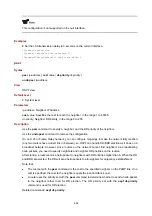
5-5
Examples
# Configure the router to send only narrow cost style packets, but receive both narrow and wide cost
style packets.
<Sysname> system-view
[Sysname] isis 1
[Sysname-isis-1] cost-style narrow-compatible
default-route-advertise (IS-IS view)
Syntax
default-route-advertise
[
route-policy route-policy-name
| [
level-1
|
level-1-2
|
level-2
] ] *
undo default-route-advertise
[
route-policy
route-policy-name
]
View
IS-IS view
Default Level
2: System level
Parameters
route-policy-name
: Specifies the name of a route policy, a string of 1 to 19 characters.
level-1
: Advertises a Level-1 default route.
level-1-2
: Advertises both Level-1 and Level-2 default routes.
level-2
: Advertises a Level-2 default route.
Description
Use the
default-route-advertise
command to advertise a default route of 0.0.0.0/0.
Use the
undo default-route-advertise
command to disable default route advertisement.
Default route advertisement is disabled by default.
Note that:
z
If no level is specified, a Level-2 default route is advertised.
z
The Level-1 default route is advertised to other routers in the same area, while the Level-2 default
route is advertised to all the Level-2 and Level-1-2 routers.
z
Using the
apply isis level-1
command in route policy view will generate a default route in a
Level-1 LSP. Using the
apply isis level-2
command in route policy view will generate a default
route in a Level-2 LSP. Using the
apply isis level-1-2
command in route policy view will generate
a default route in a Level-1 LSP and Level-2 LSP respectively.
Examples
# Advertise a Level-2 default route.
<Sysname> system-view
[Sysname] isis 1
[Sysname-isis-1] default-route-advertise
















































